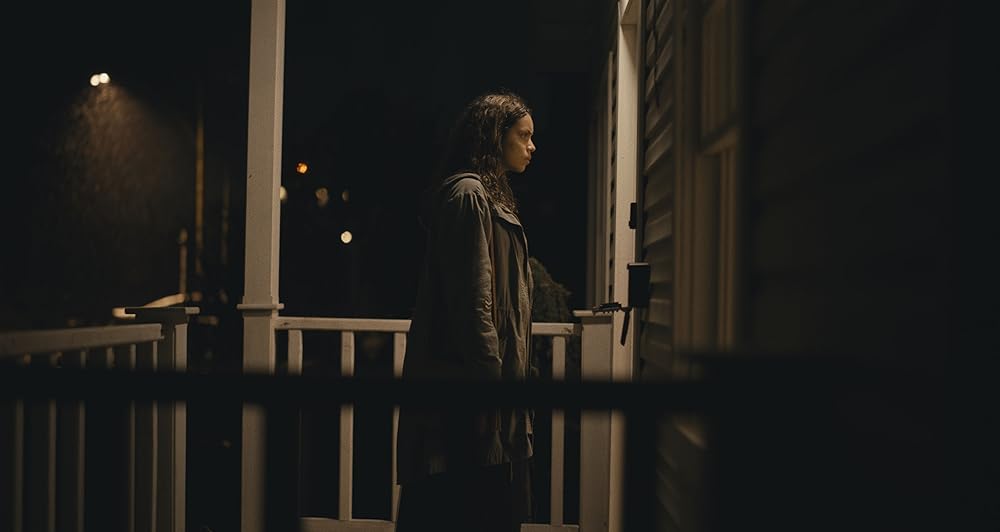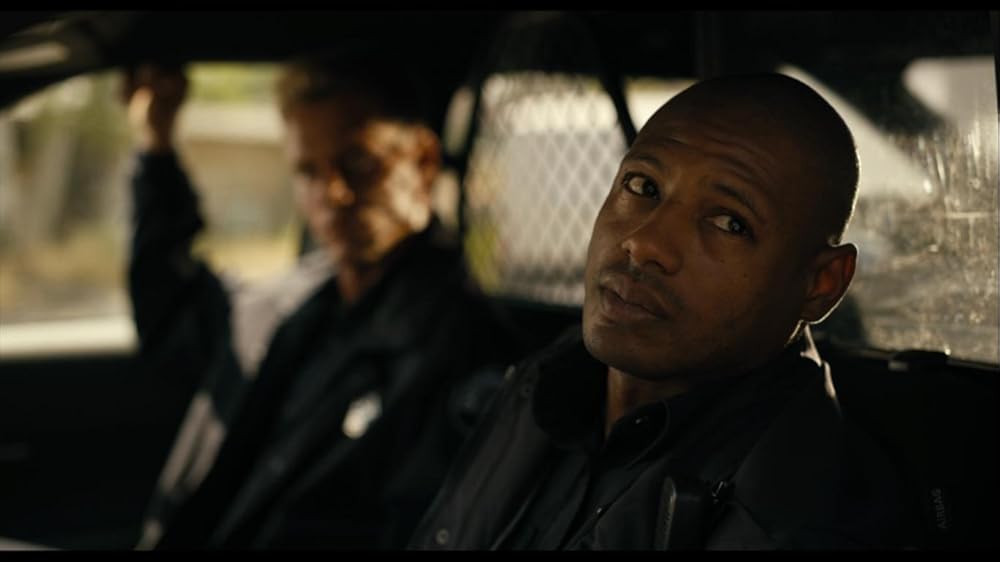|Penny Folger|

Barbarian plays at the Trylon Cinema from Friday, October 18th, through Sunday, October 20th. Visit trylon.org for tickets and more information.
“Your movie is like the Jaws of Airbnbs,”1 jokes Korey Coleman, host of the Double Toasted podcast to writer/ director Zach Cregger for whom Barbarian, in 2022, was his solo feature debut. For those who don’t remember the cultural impact of that record-breaking 1975 Spielberg film featuring a big shark, Coleman is referring to the movie that made it, from the audience’s perspective, no longer safe to go into the water.
Has Cregger done for Airbnbs what Spielberg temporarily did for the popularity of oceanfront holidays? Perhaps. Continues Coleman, “I’m about to go on a trip, and it’s freaking me out to go get an Airbnb! I’m getting a hotel instead of an Airbnb because of your movie!” High praise for someone working within the horror genre.
In Barbarian, Tess, played by Georgina Campbell, shows up at her Airbnb late on a dark, rainy night on the wrong side of Detroit, only to find that a strange man has already checked in ahead of her. Whether this is an innocuous mixup on the part of the rental company or something far more devious isn’t clear. To make things more awkward, its inhabitant, Keith, played by Bill Skarsgård, continually comments that he knows he could be seen as a danger to her. Is this a joke to lighten the mood, or an uneasiness about the way she might be perceiving him? This clumsiness on his part was written very intentionally.
Cregger wrote the script while having the realization that the experience of moving through the world as a woman might be more difficult than his own. Cregger came to directing via his comedy background, as a core member of the comedy troupe, The Whitest Kids U’ Know. He actually stumbled onto the idea for Barbarian after reading a self-help book.
“I had read a book called The Gift of Fear that was encouraging women to pay attention to these red flags that men can give off in their day-to-day interactions that might seem innocuous, but if you ignore them, you do so at your peril. I was kind of struck by the realization that this is not part of my mindset at all. As a man in the world, I don’t have to be on guard against half the population that could pose a potential threat.“2
The scene he wrote based on this idea became the introductory scene and jumping off point for the rest of the film. Cregger lists a few of Keith’s subtly questionable behaviors upon meeting Tess, i.e. some of the red flags he wrote into his initial exercise: “Him touching her luggage, making her tea she didn’t want. Saying, ‘Pretty name.’ That’s not appropriate, and a lot of guys wouldn’t notice that but I think that more women would.”3
My first experience with Barbarian was late at night on an airplane a year or two ago, so it’s difficult to resuscitate my initial impressions. But as a woman, I’m not sure the red flags he’s throwing out read as much more than awkwardness—though the situation Tess finds herself in certainly has the potential to be ominous. But there’s another layer to the looming threat in this situation that’s a bit more meta.
Audiences in test screenings for Barbarian laughed with recognition when Skarsgård was the one to open the door to the Airbnb Tess finds herself locked out of, because of his modern horror pedigree. It was kind of an “oh no, not that guy!” response that the filmmakers had not necessarily planned. Because, although he was the first person they approached, Skarsgård wasn’t cast until long after the screenplay was written. (It took two years from completion for Cregger to actually get the film financed.) The reason for this laugh of recognition was that Skarsgård plays Pennywise the clown in the modern It franchise based on the Stephen King novel. It’s arguably the role he is most known for.
Despite having seen It Chapter One in theaters when it came out (no, I never saw Chapter Two) I did not have this moment that led me to believe Skarsgård’s casting was some kind of inside joke, because, frankly, that movie didn’t leave much of an impact on me. I also don’t solely associate Skarsgård with that role. (Full disclosure: I’m much more of a 1990 It TV movie Tim Curry as Pennywise fan.)

This awkward opening scene between Tess and Keith is all they really let you see in the film’s original trailer. Yet it’s impossible to discuss much of anything about this movie without spoiling some of its surprises. Even Cregger himself has admitted in interviews, “It’s hard to talk about the movie without getting into spoilers.”4 While I will not give away many of the deeper horror elements or the general plot beyond this initial setup, a major character who’s in the marketing materials, but wasn’t initially revealed in trailers, is played by Justin Long, somewhat of a Scream King in his own right (Drag Me to Hell, Tusk, Jeepers Creepers). He has a darkly comical turn in this movie that is so good he seems worth mentioning, without going into detail about how his character is related to the rest of the story. Because as even Long himself has said about the film, “The less you know the better, going in.”5
Long’s character, AJ, is so self-involved he doesn’t even notice when he’s in danger. Much of the comedy of AJ stems directly from his, completely oblivious, male privilege. It’s the way he moves through a world in which he’s unable to feel empathy for women or see outside of himself, and it works to comedic effect when he’s genuinely in danger but is so self-obsessed that it doesn’t register. It’s the flipside of the ideas Cregger seems to be exploring with the thesis of his film: the experience of the woman who must read all the subtleties in her surroundings hyper vigilantly in order to avoid danger, while her male counterpart trips through his environment blissfully unaware. Says Cregger, “It was about exploring that theme of sexual aggression and sexual threat from the exact opposite angle.”6
Another question this movie raises: women must regularly scan their surroundings as a survival tactic, but is anyone actually able to protect them? Enter modern America’s troubled relationship with the police, particularly for people of color, though the latter is only subtlety pointed at here. When Tess tries to use the police as a strategy for solving her problems, we see how quickly this strategy fails. It seems like a comment on the ineffectiveness of police on the whole to protect, and not just antagonize, its citizens.
It’s reminiscent of Jordan Peele’s (a contemporary of Cregger’s and another horror director with a comedy background) nod to the police not exactly being an ally if you are male and black in Get Out. But the critique here adds even more nuance: while Tess is a person of color, so is the police officer who seems to think she’s a crazy street person rather than someone having a real emergency. While she’s disheveled, it’s terrifying when she realizes that from his viewpoint she is someone not to be believed, and one wonders subliminally if her race has also played a part.

Barbarian has many twists and turns, not only in its plot but in its production. Largely using Bulgaria as a stand-in for Detroit, its original financier died the night before Cregger was set to fly out there to begin filming. As a result, financing was immediately withdrawn, the crew let go, and the film was set to be canceled, before another company swooped in the very next day to save it.
As a result, the film actually got bigger. 20th Century Studios became its distributor, which is owned by Disney, making an oddball indie horror film starring Bill Skarsgård technically a Disney movie. An unfortunate outcome from this acquisition is that, although the film was made instead of just folding, it doesn’t look like it may ever receive a physical release: a new and troubling trend also on the part of Disney.
We’re in an age where big chain retailers like Best Buy sell DVD—and VHS!—cleaners but have discontinued selling physical media/ DVD offerings completely. (An odd acknowledgement that people still use these formats, but a refusal to continue to perpetuate them.) This is a much bigger conversation, but it’s a loss of ownership for fans, particularly for horror fans who enjoy collecting physical copies of their favorite films. It raises further questions: if you pay to view something digitally do you ever really “own” it? Not to mention the treasure trove of extra features typically included on physical media releases, and often not available elsewhere. Where will future film researchers access these things as easily?
Barbarian was initially an indie movie that reached a much larger audience and was a financial and critical success. Here is one small petition that’s been created for its DVD release. But will a behemoth like Disney listen to the desires of a few hundred people? If innovative, thought-provoking indie movies are being created more rapidly in horror than they are in other genres, this is great for horror fans. But will they increasingly only be able to temporarily lease out digital copies of these things in the end? If these are our only options at present, watching Barbarian with an audience of fans at Trylon Cinema is at least the best way to see it.
- “Zach Cregger (Director and writer of ‘Barbarian’) interview”, Double Toasted Interviews, September 30, 2022. ↩︎
- Dakota Lee Dahl, “Interview: Filmmaker Zach Cregger on the Terrors of ‘Barbarian,’” Rue Morgue, September 12, 2022. ↩︎
- “Barbarian Cast and Director Share Behind-the-Scenes Secrets About the Horror Movie,” Collider Interviews (August 2022). Los Angeles, California. ↩︎
- “Director Zach Cregger Talks ‘The Barbarian’ Spoilers,” ReelBlend Podcast, podcast audio, September 14, 2022. ↩︎
- “Barbarian Cast and Director Share Behind-the-Scenes Secrets About the Horror Movie,” Collider Interviews (August 2022). Los Angeles, California. ↩︎
- “Barbarian Cast and Director Share Behind-the-Scenes Secrets About the Horror Movie,” Collider Interviews (August 2022). Los Angeles, California. ↩︎
Edited by Matthew Tchepiova-Treon
